17
2
About the Series
First off, you may treat this like any other code golf challenge, and answer it without worrying about the series at all. However, there is a leaderboard across all challenges. You can find the leaderboard along with some more information about the series in the first post.
Although I have a bunch of ideas lined up for the series, the future challenges are not set in stone yet. If you have any suggestions, please let me know on the relevant sandbox post.
Hole 6: Roll a d20
A very common die in table-top RPGs is the twenty-sided die (an icosahedron, commonly known as d20). It is your task to roll such a die. However, if you were just returning a random number between 1 and 20, that would be a bit trivial. So your task is to generate a random net for a given die.
We'll use the following net:
It's a triangle strip, so it can be easily represented as a list of integers. E.g. if you are given the input:
[1, 2, 3, 4, 5, 6, 7, 8, 9, 10, 11, 12, 13, 14, 15, 16, 17, 18, 19, 20]
That would correspond to the following die (fun fact: this is the net used by Magic: the Gathering life counters/spin-down dice).
However, this is not the only net representing this die. Depending on how we unroll the faces, there are 60 different nets. Here are two more:
[1, 8, 9, 10, 2, 3, 4, 5, 6, 7, 17, 18, 19, 11, 12, 13, 14, 15, 16, 20]
[10, 9, 18, 19, 11, 12, 3, 2, 1, 8, 7, 17, 16, 20, 13, 14, 4, 5, 6, 15]
Or graphically (I didn't rotate the face labels for simplicity):
The Challenge
Given an a list of integers representing a die (as described above) and an integer N, output N independently, uniformly random d20 nets corresponding to the given die. (That is, each of the 60 possible nets should have the same probability of being generated.)
Of course, due to the technical limitations of PRNGs, perfect uniformity will be impossible. For the purpose of assessing uniformity of your submission, the following operations will be regarded as yielding perfectly uniform distributions:
- Obtaining a number from a PRNG (over any range), which is documented to be (approximately) uniform.
- Mapping a uniform distribution over a larger set of numbers onto a smaller set via modulo or multiplication (or some other operation which distributes values evenly). The larger set has to contain at least 1024 times as many possible values as the smaller set.
Given these assumptions your algorithm must yield a perfectly uniform distribution.
Your program should be able to generate 100 nets in less than a second (so don't try generating random nets until one corresponds to the die given above).
You may write a program or function, taking input via STDIN (or closest alternative), command-line argument or function argument and outputting the result via STDOUT (or closest alternative), function return value or function (out) parameter.
Input and output may be in any convenient, unambiguous, flat list format. You may assume that the face values of the d20 are distinct, positive integers, which fit into your language's natural integer type.
This is code golf, so the shortest submission (in bytes) wins. And of course, the shortest submission per user will also enter into the overall leaderboard of the series.
Sample Outputs
For the input
[1, 2, 3, 4, 5, 6, 7, 8, 9, 10, 11, 12, 13, 14, 15, 16, 17, 18, 19, 20]
The 60 possible nets (provided I didn't make a mistake), in no particular order, are:
[11, 10, 9, 18, 19, 20, 13, 12, 3, 2, 1, 8, 7, 17, 16, 15, 14, 4, 5, 6]
[1, 2, 3, 4, 5, 6, 7, 8, 9, 10, 11, 12, 13, 14, 15, 16, 17, 18, 19, 20]
[8, 7, 17, 18, 9, 10, 2, 1, 5, 6, 15, 16, 20, 19, 11, 12, 3, 4, 14, 13]
[3, 12, 13, 14, 4, 5, 1, 2, 10, 11, 19, 20, 16, 15, 6, 7, 8, 9, 18, 17]
[3, 4, 5, 1, 2, 10, 11, 12, 13, 14, 15, 6, 7, 8, 9, 18, 19, 20, 16, 17]
[11, 19, 20, 13, 12, 3, 2, 10, 9, 18, 17, 16, 15, 14, 4, 5, 1, 8, 7, 6]
[4, 14, 15, 6, 5, 1, 2, 3, 12, 13, 20, 16, 17, 7, 8, 9, 10, 11, 19, 18]
[2, 10, 11, 12, 3, 4, 5, 1, 8, 9, 18, 19, 20, 13, 14, 15, 6, 7, 17, 16]
[4, 5, 1, 2, 3, 12, 13, 14, 15, 6, 7, 8, 9, 10, 11, 19, 20, 16, 17, 18]
[10, 2, 1, 8, 9, 18, 19, 11, 12, 3, 4, 5, 6, 7, 17, 16, 20, 13, 14, 15]
[3, 2, 10, 11, 12, 13, 14, 4, 5, 1, 8, 9, 18, 19, 20, 16, 15, 6, 7, 17]
[7, 8, 1, 5, 6, 15, 16, 17, 18, 9, 10, 2, 3, 4, 14, 13, 20, 19, 11, 12]
[13, 12, 11, 19, 20, 16, 15, 14, 4, 3, 2, 10, 9, 18, 17, 7, 6, 5, 1, 8]
[16, 15, 14, 13, 20, 19, 18, 17, 7, 6, 5, 4, 3, 12, 11, 10, 9, 8, 1, 2]
[15, 16, 17, 7, 6, 5, 4, 14, 13, 20, 19, 18, 9, 8, 1, 2, 3, 12, 11, 10]
[20, 13, 12, 11, 19, 18, 17, 16, 15, 14, 4, 3, 2, 10, 9, 8, 7, 6, 5, 1]
[5, 4, 14, 15, 6, 7, 8, 1, 2, 3, 12, 13, 20, 16, 17, 18, 9, 10, 11, 19]
[10, 11, 12, 3, 2, 1, 8, 9, 18, 19, 20, 13, 14, 4, 5, 6, 7, 17, 16, 15]
[4, 3, 12, 13, 14, 15, 6, 5, 1, 2, 10, 11, 19, 20, 16, 17, 7, 8, 9, 18]
[19, 20, 13, 12, 11, 10, 9, 18, 17, 16, 15, 14, 4, 3, 2, 1, 8, 7, 6, 5]
[1, 8, 9, 10, 2, 3, 4, 5, 6, 7, 17, 18, 19, 11, 12, 13, 14, 15, 16, 20]
[8, 1, 5, 6, 7, 17, 18, 9, 10, 2, 3, 4, 14, 15, 16, 20, 19, 11, 12, 13]
[18, 9, 8, 7, 17, 16, 20, 19, 11, 10, 2, 1, 5, 6, 15, 14, 13, 12, 3, 4]
[12, 3, 2, 10, 11, 19, 20, 13, 14, 4, 5, 1, 8, 9, 18, 17, 16, 15, 6, 7]
[2, 3, 4, 5, 1, 8, 9, 10, 11, 12, 13, 14, 15, 6, 7, 17, 18, 19, 20, 16]
[10, 9, 18, 19, 11, 12, 3, 2, 1, 8, 7, 17, 16, 20, 13, 14, 4, 5, 6, 15]
[9, 8, 7, 17, 18, 19, 11, 10, 2, 1, 5, 6, 15, 16, 20, 13, 12, 3, 4, 14]
[16, 17, 7, 6, 15, 14, 13, 20, 19, 18, 9, 8, 1, 5, 4, 3, 12, 11, 10, 2]
[17, 7, 6, 15, 16, 20, 19, 18, 9, 8, 1, 5, 4, 14, 13, 12, 11, 10, 2, 3]
[1, 5, 6, 7, 8, 9, 10, 2, 3, 4, 14, 15, 16, 17, 18, 19, 11, 12, 13, 20]
[9, 18, 19, 11, 10, 2, 1, 8, 7, 17, 16, 20, 13, 12, 3, 4, 5, 6, 15, 14]
[16, 20, 19, 18, 17, 7, 6, 15, 14, 13, 12, 11, 10, 9, 8, 1, 5, 4, 3, 2]
[5, 1, 2, 3, 4, 14, 15, 6, 7, 8, 9, 10, 11, 12, 13, 20, 16, 17, 18, 19]
[8, 9, 10, 2, 1, 5, 6, 7, 17, 18, 19, 11, 12, 3, 4, 14, 15, 16, 20, 13]
[13, 20, 16, 15, 14, 4, 3, 12, 11, 19, 18, 17, 7, 6, 5, 1, 2, 10, 9, 8]
[6, 15, 16, 17, 7, 8, 1, 5, 4, 14, 13, 20, 19, 18, 9, 10, 2, 3, 12, 11]
[6, 5, 4, 14, 15, 16, 17, 7, 8, 1, 2, 3, 12, 13, 20, 19, 18, 9, 10, 11]
[7, 6, 15, 16, 17, 18, 9, 8, 1, 5, 4, 14, 13, 20, 19, 11, 10, 2, 3, 12]
[19, 18, 17, 16, 20, 13, 12, 11, 10, 9, 8, 7, 6, 15, 14, 4, 3, 2, 1, 5]
[14, 15, 6, 5, 4, 3, 12, 13, 20, 16, 17, 7, 8, 1, 2, 10, 11, 19, 18, 9]
[17, 18, 9, 8, 7, 6, 15, 16, 20, 19, 11, 10, 2, 1, 5, 4, 14, 13, 12, 3]
[6, 7, 8, 1, 5, 4, 14, 15, 16, 17, 18, 9, 10, 2, 3, 12, 13, 20, 19, 11]
[14, 13, 20, 16, 15, 6, 5, 4, 3, 12, 11, 19, 18, 17, 7, 8, 1, 2, 10, 9]
[20, 19, 18, 17, 16, 15, 14, 13, 12, 11, 10, 9, 8, 7, 6, 5, 4, 3, 2, 1]
[7, 17, 18, 9, 8, 1, 5, 6, 15, 16, 20, 19, 11, 10, 2, 3, 4, 14, 13, 12]
[15, 6, 5, 4, 14, 13, 20, 16, 17, 7, 8, 1, 2, 3, 12, 11, 19, 18, 9, 10]
[9, 10, 2, 1, 8, 7, 17, 18, 19, 11, 12, 3, 4, 5, 6, 15, 16, 20, 13, 14]
[2, 1, 8, 9, 10, 11, 12, 3, 4, 5, 6, 7, 17, 18, 19, 20, 13, 14, 15, 16]
[12, 13, 14, 4, 3, 2, 10, 11, 19, 20, 16, 15, 6, 5, 1, 8, 9, 18, 17, 7]
[17, 16, 20, 19, 18, 9, 8, 7, 6, 15, 14, 13, 12, 11, 10, 2, 1, 5, 4, 3]
[18, 17, 16, 20, 19, 11, 10, 9, 8, 7, 6, 15, 14, 13, 12, 3, 2, 1, 5, 4]
[18, 19, 11, 10, 9, 8, 7, 17, 16, 20, 13, 12, 3, 2, 1, 5, 6, 15, 14, 4]
[11, 12, 3, 2, 10, 9, 18, 19, 20, 13, 14, 4, 5, 1, 8, 7, 17, 16, 15, 6]
[15, 14, 13, 20, 16, 17, 7, 6, 5, 4, 3, 12, 11, 19, 18, 9, 8, 1, 2, 10]
[19, 11, 10, 9, 18, 17, 16, 20, 13, 12, 3, 2, 1, 8, 7, 6, 15, 14, 4, 5]
[12, 11, 19, 20, 13, 14, 4, 3, 2, 10, 9, 18, 17, 16, 15, 6, 5, 1, 8, 7]
[20, 16, 15, 14, 13, 12, 11, 19, 18, 17, 7, 6, 5, 4, 3, 2, 10, 9, 8, 1]
[13, 14, 4, 3, 12, 11, 19, 20, 16, 15, 6, 5, 1, 2, 10, 9, 18, 17, 7, 8]
[5, 6, 7, 8, 1, 2, 3, 4, 14, 15, 16, 17, 18, 9, 10, 11, 12, 13, 20, 19]
[14, 4, 3, 12, 13, 20, 16, 15, 6, 5, 1, 2, 10, 11, 19, 18, 17, 7, 8, 9]
For any other net, simply replace every occurrence of i with the ith number in the input (where i is 1-based).
Related Challenges
Leaderboard
The first post of the series generates a leaderboard.
To make sure that your answers show up, please start every answer with a headline, using the following Markdown template:
## Language Name, N bytes
where N is the size of your submission. If you improve your score, you can keep old scores in the headline, by striking them through. For instance:
## Ruby, <s>104</s> <s>101</s> 96 bytes
(The language is not currently shown, but the snippet does require and parse it, and I may add a by-language leaderboard in the future.)
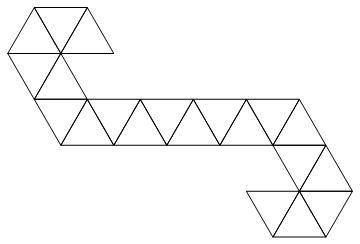
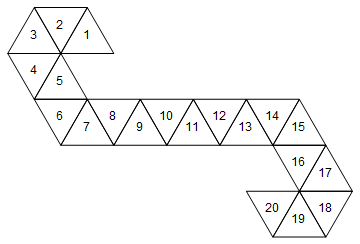
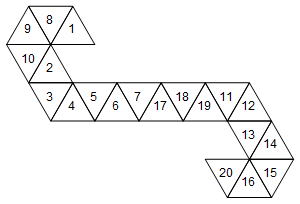
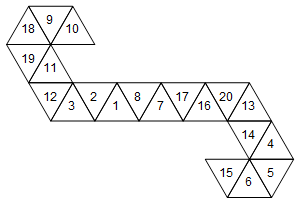
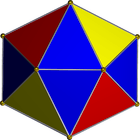
Regarding our discussion, I've added the word "must" to make it clearer. I think that closes the loophole I've been taking advantage of. Still, I think the approach I used (though invalid) is interesting. – Level River St – 2015-12-11T09:57:04.733
This is almost exactly like my sandbox post! – Rɪᴋᴇʀ – 2015-12-11T17:18:19.567
@RikerW That's what I thought when you sandboxed it. ;) (At the time, mine was directly below yours. I thought this one inspired yours.) Yours is obviously much simpler though (which is probably a good thing). – Martin Ender – 2015-12-11T17:19:31.417
Never saw yours. That's weird, I thought I read all of the ones on the first page. But no, I made mine independently. – Rɪᴋᴇʀ – 2015-12-11T17:22:12.337
Shouldn´t that be titled "unfold a d20"? – Titus – 2016-11-20T17:21:32.477
@Titus This challenge is not about generating the net. It's about permuting the faces in a way which corresponds to a rigid rotation of the entire d20. – Martin Ender – 2016-11-20T17:22:27.143